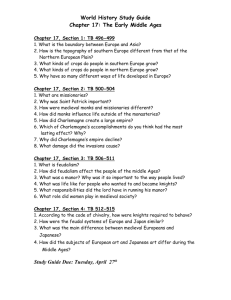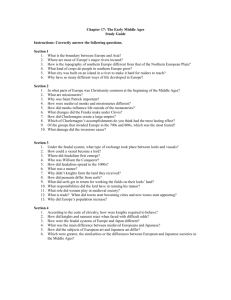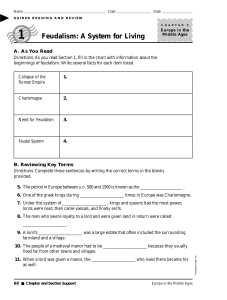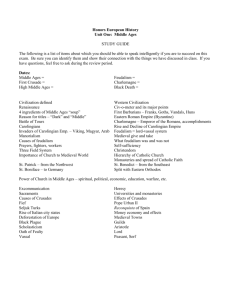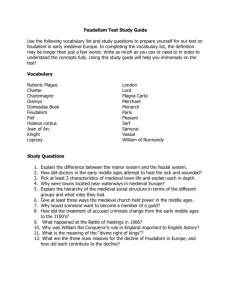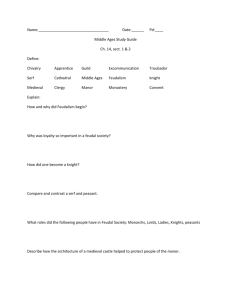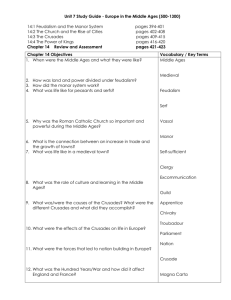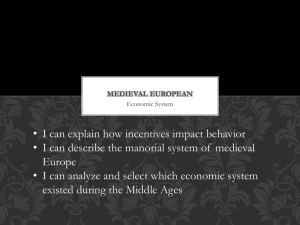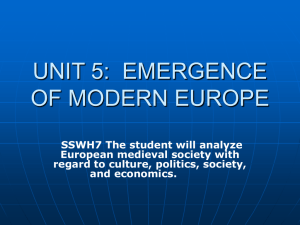The Rise of Europe
advertisement
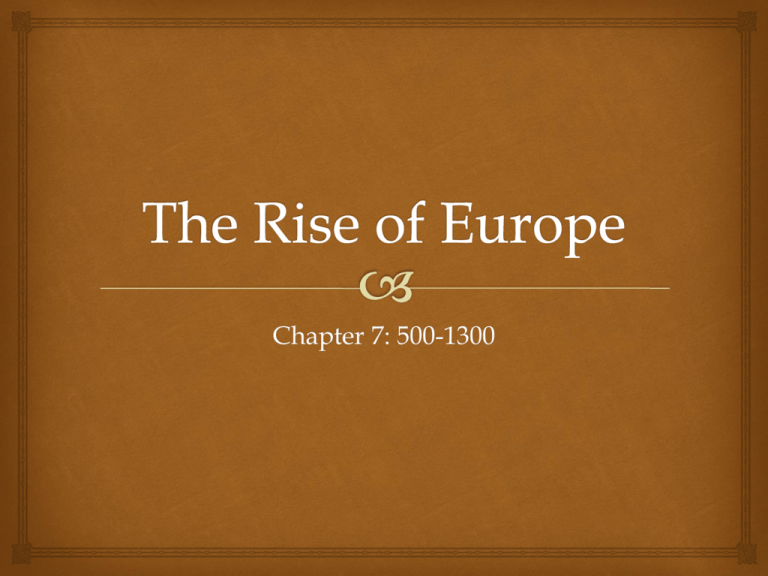
Chapter 7: 500-1300 Section 1: The Early Middle Ages Collapse of the Roman Empire created a decline in Western Europe Invaders, trade declined, towns emptied, very little classical learning Cut off from advanced civilizations in India, Middle East, & China Referred to as the Dark Ages ~500-1500 Time between ancient and modern times Currently, it is the Medieval, or Middle Ages The Early Middle Ages Germanic Tribes Goths, Vandals, Saxons, Franks Farmers and herders lived in small communities Kings were elected and warriors served Clovis, King of the Franks-he conquered Gaul 486 He converted to Christianity- made an ally in the Pope Islam, began in Arabia Took over Christian lands from Palestine to Spain 732 Battle of Tours Christians triumphed over the Muslims and they no longer advanced into Charles Martel Western Europe. rallied Frankish warriors Age of Charlemagne Charles Martel’s grandson 768 became king of the Franks CharlemagneCharles the Great Charlemagne was proclaimed Emperor of the Romans for helping Pope Leo III against rebellious nobles in Rome This upset the emperor in the Eastern Roman Empire- and further divided the two Christian worlds. Fought the Muslims, Saxons, Avars, Slavs, and Lombards Briefly united Western Roman Empire United Christian Empire The Early Middle Ages Age of Charlemagne Charlemagne's Legacy Spread Christianity throughout the land and converted many other groups. Officials to carry out laws and keep detailed records. Education Encouraged local schools and wanted Latin to be taught Extended Christian empire Blended Germanic, Roman, & Christian traditions. Strong and efficient governments. The Early Middle Ages Europe After Charlemagne After he died in 814 his son took over, Louis I Louis I, sons battled for power-the three divided the empire into three regions, Treaty of Verdun Invasions Muslims continued to threaten Vikings Farmers and sailors, traders, and explorers Destructive raiders Vikings Ended last thread of Charlemagne’s unity Late 700s left Scandinavia Looted & burned Skilled raiders 11/3 Bell Ringer Who was Charlemagne? What was he known for? Full sentences! Section 2: Feudalism and the Manor Economy Invasions by Vikings & Muslims, Kings & Emperors too weak to maintain law & order But people still need protection decentralized structure Feudalism Powerful local lords divided their landholdings among lesser lords called vassals who pledged loyalty & service to greater lord Land for loyalty = estate Section 2: Feudalism and the Manor Economy Knights Left at age 7-to the Warfare was a way of life castle of his father’s lord. Rival lords Learned to ride, fight Discipline and training were harsh and strict Fought on horsebackswords, axes, and lances as weapons http://www.history.com/topics/middleages/videos/heavy-cavalry-of-the-middleWore armor and carried ages Tournaments- Mock Battles Pg. 220 Castles Feudalism and the Manor Economy Stone high walls, towers, and drawbridges over moats. Homes for the lords and fortresses https://www.youtube.com/watch?v=I6C bMSU8HX8 Feudalism and the Manor Economy Noblewomen Took over while the husband or father was away Some women did inherit land-most land went to the firstborn son Women were sent for training in weaving, spinning, and supervising servants Some learned to read and write Expected to have many children and serve her husband Chivalry Code of conduct Brave, Loyal, and true to their word Manors Support Feudalism Manor- Lord’s estate Most included 1 or more villages & surrounding lands Lord, Peasants, and Serfs Serfs, tied to the land Peasants- worked farming the land, repairing bridges and roads. Must ask permission to marry, and they paid to use the grain mill. In return, they had land to farm, protection from war. They had food, housing, and land. Feudalism and the Manor Economy The manor produced everything they needed Peasants didn’t have schooling Rarely left Self-sufficient Cottages and huts are where the peasants lived. A church, lord’s house, and grain mill were close by. Around the village were strips of land where they farmed, then land for the animals and hay. Life Men, women and children all worked harsh long hours. Black bread (Rye) with cabbage, turnips, and onions was a common meal. Rarely did they have meat. Families kept their animals in their huts with them at night. Christmas and Easter were time to celebrate! A week off of work, eating, dancing, and sports took place during this time. Section 3: The Medieval Church Cathedrals The Church was incredibly important to daily life. Priests interpreted the Bible, guided people on morale issues, helped the sick and needy. Holidays and celebrations happened at the Church Tithe or tax (1/10 of their income) went to Church Churches started as small wooden structures, then to stone buildings Gothic style large ornate buildings. • Pointed arch • Vaulting • Ornamentation • Ornate The Medieval Church Men and women are equal before God. On Earth, women are weak and easily led into sin Minimum age for marriage, harsh punishments to men that harm women Church tried to protect them Monasteries and Convents Monks (Men) Nuns (Women) Benedictine Rule Obedience to the monastery Poverty World without schools & hospitals Chastity (purity) They educated, took care of the sick, and helped others in any way they could. The Medieval Church Church Power Grows Popes claimed Papal Supremacy, authority over all rulers. Canon Law (churches own body of laws) Governed wills, marriage, and morals. Punishments Excommunication-not allowed to receive sacraments Interdict-an entire town, region or kingdom not being allowed to receive sacraments. The Medieval Church Corruption Wealth began corrupting monks and nuns. Priests that married, spent less time at the Church. Early 900’s Reform Benedict Rule was imposed again. Bishops and nobles had no part in church affairs (left to the pope) Friars Traveling monks that preached to the poor. The Medieval Church Jews Lived peacefully with Muslims and Christians for hundreds of years. Prejudice from Christians increased. Jews were Late 1000s blamed for illnesses or famine. They were forbidden from owning land or having jobs. Persecution forced the Jews to moved eastward in Eastern Europe, where they were welcomed. Section 4: Economic Recovery Sparks Change Agriculture Revolution Iron Plows and harnesses for horses allowed for larger fields Peasants cleared more unused land and increased the land in which to plant New system of planting revived the soil and fed more of the population. Section 4: Economic Recovery Sparks Change Revival of Trade and Travel Chinese silks, gold jewelry, Asian spices were all traded throughout Europe. Towns first began as merchants set up centers to make and sell goods. As manor populations grew, lords allowed peasants to buy their freedom and move to towns. Economic Recovery Sparks Change A Commercial Revolution Money became more important as trade increased. Money allowed peasants to sell their goods and services rather than only work for the lords. Capital, money for investments. banking Merchants joined in partnerships for large business ventures. Insurance allowed merchants to protect their shipments. Credit was used instead of cash or gold coins, practice Europeans took from the Muslims. Tenant farmers emerged, paying rent for farmland. Economic Recovery Sparks Change The Rise of Middle Class Middle Class Group of merchants and artisans-between the nobles and peasants. Nobles & clergy despise it Economic Recovery Sparks Change The Rise of Middle Class Guilds Merchants Passed laws and taxes, chose what to spend town money on. Artisans Workers for each occupation, limited memberships. Only members could work in that trade. Regulated hours, quality, and set prices. Guild Members At 7 or 8, a child becomes an apprentice, trainee Apprentice for 7 years, did not get paid, but the guild master provides housing and training. Few became guild masters, many were journeymen, the salaried workers Women Same trade as husband or father Ribbon making and papermaking Economic Recovery Sparks Change Town and City Life Overcrowding So many people led to people adding more floors to their houses. Churches with tall steeples were in almost every town or city. No garbage pick up or sewer systems. Waste was thrown into the streets. Towns were filthy, smelly, noisy, and crowded! Perfect breeding ground for disease
